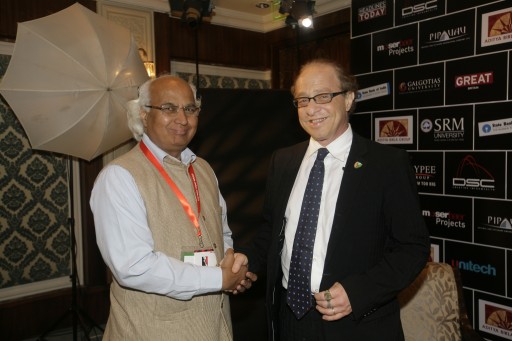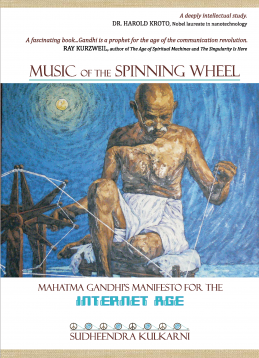Music of the Spinning Wheel | Mahatma Gandhi is a prophet for the age of the communication revolution: Sudheendra Kulkarni interviews Ray Kurzweil
April 5, 2012
Music of the Spinning Wheel — April 5, 2012 | Sudheendra Kulkarni

Ray Kurzweil with Sudheendra Kulkarni at the India Today Conclave in New Delhi, India, March 17, 2012. (credit: India Today)
Mahatma Gandhi is a prophet for the age of the communication revolution: An interview with Dr. Ray Kurzweil by Sudheendra Kulkarni
Ray Kurzweil was a speaker at the India Today Conclave in New Delhi on 17 March 2012. On the sidelines of the conclave, he was interviewed by Sudheendra Kulkarni, a prominent Indian journalist-activist and author of a forthcoming book Music of the Spinning Wheel: Mahatma Gandhi’s Manifesto for the Internet Age.
Kulkarni’s book argues that Gandhi, who had prophesied the coming of “undreamt of scientific discoveries in non-violence,” would have embraced the Internet since digital technologies have the potential to fulfill his own dream of a peaceful, just, harmonious and planet-friendly world. Removal of the man-machine antagonism was one of the strategic goals in Gandhi’s economic and moral philosophy, and he made his favorite “spiritual machine,” the spinning wheel, the emblem of his revolutionary philosophy.
“My life is my message,” Gandhi had proclaimed. His own humble machine thus became the carrier of his mighty message, anchored in Truth and Nonviolence. More than a producer of a certain kind of cloth called khadi, the spinning wheel for him was an extension of his own being, somewhat in the same way that the Internet has become an extension of the modern man — indeed, an extension and capability-enhancer of the human species itself.
Kulkarni’s book posits that the Internet has the potential — and also a historic responsibility — to emerge as an avatar or a technological reincarnation of Gandhi’s spinning wheel.
This interview will run as an annexure to Kulkarni’s book, due to be published in May by Amaryllis. He can be reached at [email protected].
Sudheendra Kulkarni: It’s an absolute honour for me to be talking to you, Dr. Kurzweil. Reading your books was a mind-expanding experience for me, and I have referred to your thoughts in my own book. As I mentioned to you, I am talking to you in connection with a book on Mahatma Gandhi that I am writing. My book explores his views on science and technology, as an integral part of his overall philosophy — best encapsulated by the title of his autobiography My Experiments with Truth.
It also posits that the future evolution of information technology will make a decisive contribution to the actualization of Gandhi’s ideals of truth, nonviolence and universal brotherhood. Contrary to popular belief, Gandhi was not opposed to science and technology. My research tells me that he had deep faith in the power of science and machines.
Indeed, he held that the greatest machine ever created is the human body itself. But machine for what purpose? That is the central question he sought to answer. He was opposed to the exploitative ends to which machines were put during the Industrial Revolution. He questioned their role in the colonization of India and other nations in Asia, Africa and Latin America, and in the exploitation and pauperization of its people. But he was not opposed to machines per se. Now the era of the Industrial Revolution is behind us, and machine itself has undergone a fundamental change with the advent of information technology. I want to begin by trying to know your views on Mahatma Gandhi.
 Ray Kurzweil: I think Mahatma Gandhi’s movement is a very good early example of the power of people coming together, sharing an idea to change an oppressive reality, and achieving that purpose nonviolently.
Ray Kurzweil: I think Mahatma Gandhi’s movement is a very good early example of the power of people coming together, sharing an idea to change an oppressive reality, and achieving that purpose nonviolently.
He did not have the benefit of electronic communication. His idea travelled by word of mouth. But he was able to set an inspiring example. Under his leadership, people came together and showed the tremendous power of peaceful collective action.
We see that happening now on a much faster scale through social networks. There are several examples in the United States of people mobilizing themselves in peaceful protest action through social networks and being able to change government decisions and laws fairly quickly, sometimes within a few days.
We’ve seen that happen also in the form of the Arab Spring. Of course, that story is not over yet. History never moves in a straight line. We don’t know how things will finally turn out. However, we’ve seen how modern communication technologies have helped people overthrow some very bad dictators.
I had predicted thirty years ago that the Soviet Union would collapse on account of the power of collective action by people communicating to each other through telephone and fax machine. The old method of the communist authorities retaining complete control over newspapers and TV stations didn’t work anymore.
I think Mahatma Gandhi’s movement was a great example of people inspired by a noble idea organizing themselves and bringing about change. He fought for social justice through constructive collective action. And that example continues to inspire the world even today. Indeed, it can be more effective today, since the world now has the tools of technology that can carry the idea far more quickly and effectively. The Internet has demonstrated the power to organize the voices of the oppressed peoples in nonviolent but effective ways. Mahatma Gandhi had done the same in his time. To me, he is a prophet for the age of the communication revolution. That is why, more people around the world are trying to know about his life and his philosophy through the Internet than ever before.
Sudheendra Kulkarni: The story of Gandhi’s satyagraha movement belongs to the past. But do you think that it will be relevant in the future?
Ray Kurzweil: It has tremendous relevance today and tomorrow. Especially the power of peaceful collective action for bringing about a positive change. Because if you start organizing yourselves violently, then it’s very hard to understand the moral authority of either side. The Civil Rights Movement in the United States led by Martin Luther King, in which I participated, was directly inspired by Mahatma Gandhi. Martin Luther King made frequent references to Gandhi. So it’s an example that is repeated over and over again. I cannot think of another example in human history in which ordinary people organized themselves peacefully and brought about great change.
Sudheendra Kulkarni: When did you first get introduced to the name and philosophy of Mahatma Gandhi?
Ray Kurzweil: Gandhi is a great icon in the United States. I had read about him as a child in children’s books. I continued to read about him in high school and college. He was always an inspiring figure to me because he embodied the philosophy of selfless service and nonviolent struggle to overcome oppression. I was very active in the Civil Rights Movement in the United States in the 1960s. I participated in the Civil Rights marches in the South and in Washington DC. Mahatma Gandhi was definitely a hero of that movement.
Sudheendra Kulkarni: That inspiration that you as a young man felt was for a particular cause and for a particular movement. But now you are a renowned inventor and a thought leader for the digital age. Does Mahatma Gandhi continue to inspire you?
Ray Kurzweil: The reason I respect him more is that, like him, I like the experience of solving people’s problems. What’s exciting about coming up with technological invention is that it can overcome some limitation or suffering of human beings. The most satisfying research project that I have stayed involved in for the past thirty-five years is a reading machine for the blind. Mahatma Gandhi followed the same path. He saw suffering and he put his mind to overcoming it. This shows the ability of the human thought to overcome suffering if you are passionate about your goal. And even though Gandhi was not a technology inventor, he demonstrated that human suffering can be overcome through the devoted application of human thought.
Sudheendra Kulkarni: Do you think that information technology, the way it is evolving now, will be a force to serve the cause of peace and nonviolence in the world? Gandhi had prophesied the coming of “undreamt of scientific discoveries in non-violence”. Is information technology likely to fulfill that prophecy?
Ray Kurzweil: I think it does that. People talk about the wisdom of the crowd in the age of the Internet. Wisdom of the collective is always greater than the wisdom of any of the individuals. And electronic communication does harness the wisdom of the crowd. Let’s say, a set of people in a country or in different parts of the world have a particular disease. They all will get insights about what to do, and they will share these insights in the group electronically. And this knowledge will be far greater than any individual or any doctor can possibly have.
On the opposite end of the spectrum, we also see the ‘wisdom’ of the lynch mobs. In the United States, bullying over the Internet has become a big issue. So technology can always be used for both good and bad purposes. But the chances of it being used for peace and human good are far greater.
Sudheendra Kulkarni: You have argued in your books that the distinction between technology and biology will begin to blur in the decades ahead. As information technology becomes integral to our being, including our bodies, do you think that human beings will begin to be driven more and more by what is good for them — good for themselves as individuals and also good for the human race and the planet as a whole?
Ray Kurzweil: I believe that that’s true. Technology is becoming more and more like biology. It’s inspired by biology. We are beginning to learn about the limitations of human thought. What leads us to be prejudiced, for example. And these technologies — social networks etc, and the dialogue and lobbying that they facilitate — help in overcoming ignorance and prejudices.
See how information and communication technologies are making our world more democratic. Even on the level of politics, if we look back to the middle of the last century, there were very few democracies in the world. Today most countries are democracies, even though they may not be perfect. Information and communication technologies are also democratising human interactions in other ways. For example, the interaction between students and teachers. Students now have access to knowledge from many other sources, and are not dependent on teachers alone. The same is true about the interaction between patients and doctors. If a patient has a chronic disease, and if she is networked with the community having the same disease, then she knows all about it. Similarly, political activists who are part of a social network can come together, raise funds in just three minutes, and solve a problem by taking decisions collaboratively. Now groups of networked people can solve problems ways that individuals could not do earlier, and this is being demonstrated in more and more areas.
Sudheendra Kulkarni: There is another way in which the future possibilities in information technology are going to actualize Mahatma Gandhi’s ideals. Take 3-D printing, for example. It is likely to completely change the current paradigm of manufacturing. No more physical transportation of manufactured goods. This is going to make decentralization of manufacturing possible. And decentralization was one of the cornerstones of Mahatma Gandhi’s economic philosophy.
Ray Kurzweil: You are correct. Decentralization is also the cornerstone of the future of technology. 3-Dimensional printing is going to decentralize manufacturing. Indeed, we are coming closer to a point when we can make all the parts of a 3D printer using 3D printing technology! And 3-D printers are going to become more and more inexpensive. So people will have the ability to print — that is, manufacture on their own — almost all that they need. High-quality clothing, the materials they need to build their homes, and all these at very low costs. So technology will not only decentralize manufacturing, but it will also democratize the economy.
Sudheendra Kulkarni: Yes. That too was one of Gandhi’s ideals. But I think that 3-D printing will also lead to elimination of waste.
Ray Kurzweil: That’s true. It will also lead to more personalization. You can design your clothes exactly the way you want. You can design your home the way you want.
I think technologies such as 3-D printing will also help us overcome poverty. We have plenty of resources on our planet, but we are not using them efficiently. Centralized manufacturing makes very inefficient use of resources. It forces us to make large quantities of the same thing at one place, and transport them to places of consumption. But people are different, and they need different things. So, in future, they can make things that they want, the way that they want them, at the time when they want them, and in quantities in which they need. And when they don’t need a thing anymore, they can simply recycle it and make something else that they need.
Sudheendra Kulkarni: So personal choice will be built into the new decentralized economy.
Ray Kurzweil: Exactly.
Sudheendra Kulkarni: Every tool or technology — be it a stick or a mobile phone — extends human capabilities. I have argued in my book that, whereas the tools or machines in the past were external to man, the tools and technologies in the digital era are becoming internal and integral to our beings. Hence, these hold the promise of extending and augmenting human capabilities in unimaginable ways.
Ray Kurzweil: That’s right. But this distinction between external and internal is not very material. The mobile phone that I carry in my hand may seem external to me, but it is now an integral part of how I work and how I live my life. Of course, computers are getting smaller and smaller, and sometime in the future they will get implanted in our bodies and brains. It’s already happening. There are different neural implants. People with Parkinson’s disease can have a computer put inside their bodies and connected into their brains. For the deaf, there are computerized hearing devices. Artificial pancreas is being experimented with. And so is the artificial heart. Research is happening on artificially augmenting the capabilities of almost every organ of the body. Putting computerized devices in our bodies and brains will become quite common in a couple of decades.
Sudheendra Kulkarni: Your book ‘The Singularity Is Here’ argues that well before the end of this century, machine intelligence will exceed human intelligence. But it seems to me that it’s important to understand what intelligence truly means. The capability that is built into computers is one kind of intelligence. It can be called computational intelligence with a certain degree of analytical and cognitive capability. However, humans are also blessed with emotional intelligence, cultural intelligence, aesthetic intelligence and spiritual intelligence. A more commonplace way of highlighting this difference is by recognizing the difference between information, knowledge, wisdom and spiritual enlightenment. What are your thoughts on this?
Ray Kurzweil: I regard human evolution as a spiritual process. Man’s biological evolution is now being accelerated and augmented by technological evolution. After ‘Singularity’ is reached, the distinction between the two will disappear. Both will together expand human consciousness, which I believe has a sacred quality. Consciousness is the ultimate repository of all moral and spiritual values, such as tolerance, compassion and love. Evolution of consciousness means that man will become God-like, although humans can never become God.
Sudheendra Kulkarni: One of the central thoughts in Mahatma Gandhi’s philosophy is the oneness of God and respect for all religions. I heard you echo the same thought in your talk at the India Today Conclave. How did you arrive at this understanding?
Ray Kurzweil: My parents brought me up in a Unitarian Church. This is a religious organization in the United States devoted to studying all the different religions. It does not have any dogma of its own. The religious education in this church involves learning about a particular religion for six months, and then moving on to another religion for the next six months. It meant taking part on those services, reading those books and inviting those religious leaders into our discussion. Thus, I studied Hinduism, Buddhism, Judaism, and so on. The theme I learnt in all the religions was the same — namely, there are many paths leading to the same truth. Different religions tell different stories in different words, but they all talk about the same God and they all teach the same values. And I was quite active in promoting this theme. I had joined a national organization called the Liberal Religious Youth. I went for its summer camps. This influence has remained a part of my philosophy.
Sudheendra Kulkarni: You are an iconic figure in the field of technology. Are you religious?
Ray Kurzweil: I believe that there is wisdom in religion — in all religions. Understanding this leads to tolerance, which is very important and necessary. Of course, there are some people who believe that their truth is the only truth, and they do not appreciate others’ traditions. I believe that we need more tolerance in our world.
Sudheendra Kulkarni: There is a Sanskrit maxim in our tradition, which echoes your belief. It says ‘Ekam sat, viprah bahudha vadanti’ — Truth is One, wise people interpret it differently.
Ray Kurzweil: That’s right. Tolerance is what we learn from Gandhi.
